Meine kleine Sammlung an Börsenstatistiken - Älteste Beiträge zuerst (Seite 6)
eröffnet am 02.08.17 21:51:33 von
neuester Beitrag 03.01.24 14:57:17 von
neuester Beitrag 03.01.24 14:57:17 von
Beiträge: 204
ID: 1.258.587
ID: 1.258.587
Aufrufe heute: 6
Gesamt: 23.449
Gesamt: 23.449
Aktive User: 0
ISIN: US78378X1072 · WKN: CG3AA5
5.065,04
PKT
+0,19 %
+9,80 PKT
Letzter Kurs 17.04.24 Citigroup
Neuigkeiten
15:46 Uhr · wallstreetONLINE Redaktion |
16:04 Uhr · dpa-AFX |
15:31 Uhr · wallstreetONLINE Redaktion |
15:20 Uhr · BNP Paribas Anzeige |
15:00 Uhr · dpa-AFX |
Antwort auf Beitrag Nr.: 56.441.869 von faultcode am 13.12.17 20:10:03
=> Neue Erwartungstheorie (1979):
1/ Menschen scheuen Risiken, solang ein sicherer Gewinn winkt
2/ droht allerdings ein Verlust, sind sie plötzlich zu hohen Risiken bereit, um ihn abzuwenden
Beispiel:
Bietet sich die Wahl zwischen einem sicheren Gewinn von 80 Dollar oder einer 85-prozentigen Chance auf 100 Dollar (bei 15 Prozent Risiko des Totalausfalls), so entschieden sich die meisten Menschen für die sicheren 80 Dollar.
Das ist aber nicht so, wenn man das Beispiel einfach umdreht: Sind sie vor die Wahl gestellt zwischen einem sicheren Verlust von 80 Dollar und der 15-Prozent-Chance auf gar keinen Verlust, wählten die meisten Menschen das Risiko - trotz der 85 prozentigen Wahrscheinlichkeit, am Ende sogar 100 Dollar zu verlieren.
Behavioral finance (BF): Neue Erwartungstheorie
aus: http://www.spiegel.de/wissenschaft/mensch/risiko-psychologie…=> Neue Erwartungstheorie (1979):
1/ Menschen scheuen Risiken, solang ein sicherer Gewinn winkt
2/ droht allerdings ein Verlust, sind sie plötzlich zu hohen Risiken bereit, um ihn abzuwenden
Beispiel:
Bietet sich die Wahl zwischen einem sicheren Gewinn von 80 Dollar oder einer 85-prozentigen Chance auf 100 Dollar (bei 15 Prozent Risiko des Totalausfalls), so entschieden sich die meisten Menschen für die sicheren 80 Dollar.
Das ist aber nicht so, wenn man das Beispiel einfach umdreht: Sind sie vor die Wahl gestellt zwischen einem sicheren Verlust von 80 Dollar und der 15-Prozent-Chance auf gar keinen Verlust, wählten die meisten Menschen das Risiko - trotz der 85 prozentigen Wahrscheinlichkeit, am Ende sogar 100 Dollar zu verlieren.
Antwort auf Beitrag Nr.: 56.593.979 von faultcode am 02.01.18 22:47:54
EN: https://en.wikipedia.org/wiki/Prospect_theory
hier eine Veranschaulichung des oben genannten Beispiels:
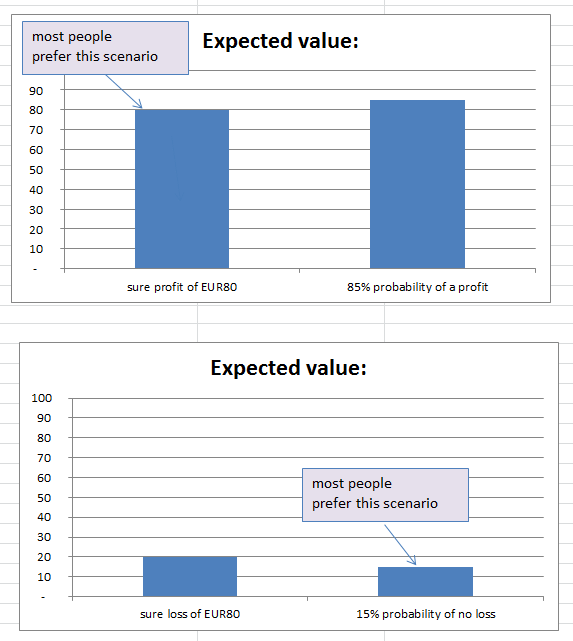
Weiter gedacht:
Nun, einmal ist bekanntlich keinmal.
Aber wie sieht es aus, wenn sich ein Marktteilnehmer 10-mal hintereinander, so wie oben die Mehrheit, entscheidet? (Und unter der Annahme, dass jede Wette von der vorherigen unabhängig ist.) =>
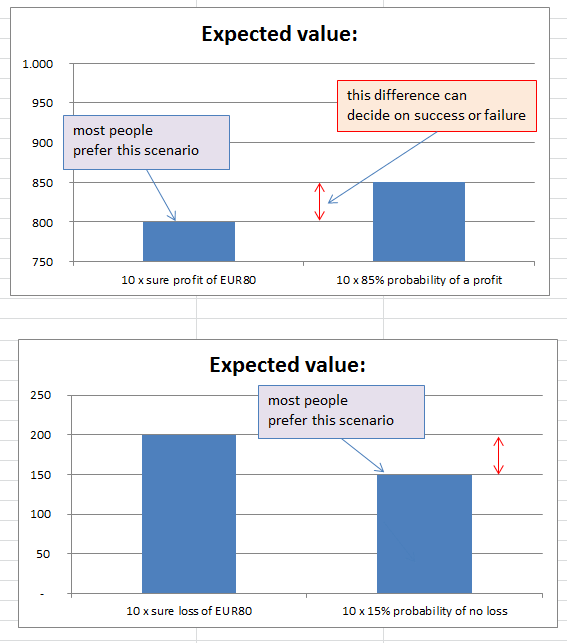
im Original: "Prospect Theory"
https://de.wikipedia.org/wiki/Prospect_TheoryEN: https://en.wikipedia.org/wiki/Prospect_theory
hier eine Veranschaulichung des oben genannten Beispiels:

Weiter gedacht:
Nun, einmal ist bekanntlich keinmal.
Aber wie sieht es aus, wenn sich ein Marktteilnehmer 10-mal hintereinander, so wie oben die Mehrheit, entscheidet? (Und unter der Annahme, dass jede Wette von der vorherigen unabhängig ist.) =>

Antwort auf Beitrag Nr.: 55.614.098 von faultcode am 28.08.17 19:44:32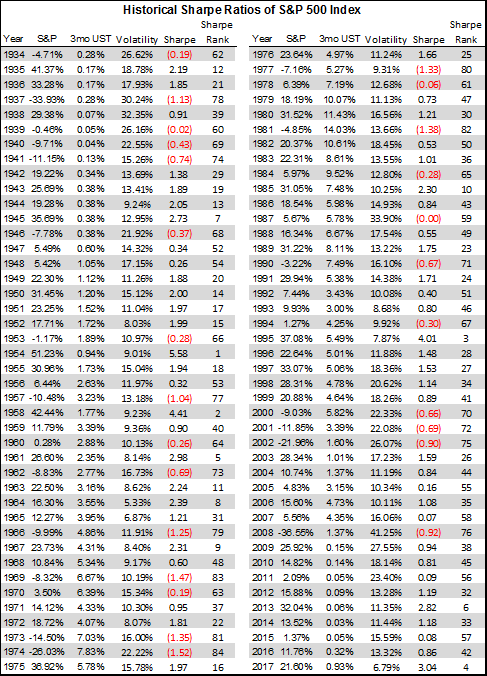
=> Aussage:
- auch nach dem "Jahrhundert-Sharpe ratio" von sagenhaften 3.04 beim S&P500 kann das Börsenjahr 2018 auch noch gut bleiben (+).
=> klar ist das Sharpe ratio 2017 (beim S&P500) so hoch und damit exzellent gewesen, wenn die Vola beim S&P500 eben so niedrig (geshortet!) war:
SRa = (R|a - R|b) / sigma|a
* SRa = Sharpe ratio S&P500
* R|a = actual return S&P500
* R|a = actual return 3-months T-bill --> meine Meinung dazu --> (++)
* sigma|a = standard deviation = (annual) volatility des S&P500
Quelle zu oben:
Historical S&P Sharpe Ratios And Thoughts On 2018
https://seekingalpha.com/article/4144483-historical-s-and-p-…
=> (+)
...While strong risk-adjusted returns have historically led to decent absolute returns in the following year, I would note that none of the top ten Sharpe Ratio years were followed by improving Sharpe ratios the next year.
In 2018, we know that we are likely to see higher short-term rates from Fed tightening. As trading action on Friday and Monday can attest, we are also likely to see an uptick in volatility from historically low levels.
Risk-adjusted returns are very likely to be lower in 2018 than what we enjoyed in 2017, and investors should adjust their expectations accordingly when making portfolio construction decisions.
------------------------------
(++)
2017: SRa|SP500 = (21.6% - 0.93%) / 6.79% = 3.04
=> soweit, so gut:
- ABER eine 3-months T-bill stellt eben nur 3 Monate lang eine annualisierte Rendite von (hier) 0.93% dar!
Die nächste 3-months T-bill eben eine etwas andere, solange bis die 12 Monate voll sind!
=> das ist eine sehr vereinfachende Rechnung, gerade in Jahren mit schwankendem (risikolosen) Zins --> dann müsste man theoretisch auch noch die Vola der T-bills berücksichtigen!!
=> es wäre besser gewesen, eine 1-Year T-bill am 1.1. bzw. Januar jeden Jahres zu verwenden:
- hier 2017-01: 0.80% aus https://fred.stlouisfed.org/series/TB1YR
=> ...und schon haben wir ein SRa|SP500 von sogar 3.06 ohne Vola-Korrektur!
S&P500: Sharpe ratios 1934 - 2017 ---> 2018e

=> Aussage:
- auch nach dem "Jahrhundert-Sharpe ratio" von sagenhaften 3.04 beim S&P500 kann das Börsenjahr 2018 auch noch gut bleiben (+).
=> klar ist das Sharpe ratio 2017 (beim S&P500) so hoch und damit exzellent gewesen, wenn die Vola beim S&P500 eben so niedrig (geshortet!) war:
SRa = (R|a - R|b) / sigma|a
* SRa = Sharpe ratio S&P500
* R|a = actual return S&P500
* R|a = actual return 3-months T-bill --> meine Meinung dazu --> (++)
* sigma|a = standard deviation = (annual) volatility des S&P500
Quelle zu oben:
Historical S&P Sharpe Ratios And Thoughts On 2018
https://seekingalpha.com/article/4144483-historical-s-and-p-…
=> (+)
...While strong risk-adjusted returns have historically led to decent absolute returns in the following year, I would note that none of the top ten Sharpe Ratio years were followed by improving Sharpe ratios the next year.
In 2018, we know that we are likely to see higher short-term rates from Fed tightening. As trading action on Friday and Monday can attest, we are also likely to see an uptick in volatility from historically low levels.
Risk-adjusted returns are very likely to be lower in 2018 than what we enjoyed in 2017, and investors should adjust their expectations accordingly when making portfolio construction decisions.
------------------------------
(++)
2017: SRa|SP500 = (21.6% - 0.93%) / 6.79% = 3.04
=> soweit, so gut:
- ABER eine 3-months T-bill stellt eben nur 3 Monate lang eine annualisierte Rendite von (hier) 0.93% dar!
Die nächste 3-months T-bill eben eine etwas andere, solange bis die 12 Monate voll sind!
=> das ist eine sehr vereinfachende Rechnung, gerade in Jahren mit schwankendem (risikolosen) Zins --> dann müsste man theoretisch auch noch die Vola der T-bills berücksichtigen!!
=> es wäre besser gewesen, eine 1-Year T-bill am 1.1. bzw. Januar jeden Jahres zu verwenden:
- hier 2017-01: 0.80% aus https://fred.stlouisfed.org/series/TB1YR
=> ...und schon haben wir ein SRa|SP500 von sogar 3.06 ohne Vola-Korrektur!
internationale REIT's als Lösung für ein (vordergründiges) Diversifikationsproblem? (1)
Eher nicht - siehe 2008:

aus:
- Euronext Reitsmarket Global Balanced NR Index
- Euronext Reitsmarket Global Conviction NR Index
NR = Net Return --> mit/ohne ausl. Quellensteuer auf Dividenden? = TRN = Net Total Return beim Dow Jones Global Select Real Estate Sec. TRN Index
aus: https://www.reitsmarket.com/
--> ich sehe nur, dass 2017 nicht gut lief (im Ggs. zu globalen Aktien) --> Mean reversion 2018?
War hier die Angst des Kaninchen vor der Schlange grösser als die tatsächliche Gefahr? (in Form von Zinserhöhungen).
Beide Indizes sind nicht wirklich global, sondern stark USA/CAN-lastig. Die EM-REIT's seien so volatil - wie gelesen im GS-Magazin 02/2018 im Interview.
Auch aufschlussreich:
- "Conviction" läuft nicht besser als "Balanced" -- siehe bei Actuarial performance (annualised):
"Conviction"
- 5Y: 8.96%
- since inception (2006): 8.46%
"Balanced"
- 5Y: +.9.92%
- since inception: +7.87%
=> mMn ist es totaler Quatsch hier 2 Indizes, die so nahe beieinander liegen nach einem solangen Zeitraum (2006-2017) zu konstruieren --> verursacht nur Kosten:
--> reicht doch, wenn man sagt "blau" ist besser als "braun":

Aber damit nicht genug! Man hat gleich 6 Indizes draus gemacht!
--> https://www.euronext.com/en/market-data-news/view/14326
- mit NR
- ohne NR
- als Decrement --> a pre-determined amount (a ‘synthetic dividend’) is withdrawn periodically:
NL0012645238 Euronext Reitsmarket Global Balanced
NL0012645246 Euronext Reitsmarket Global Balanced NR
NL0012645253 Euronext Reitsmarket Global Balanced DECR
NL0012645204 Euronext Reitsmarket Global Conviction
NL0012645212 Euronext Reitsmarket Global Conviction NR
NL0012645220 Euronext Reitsmarket Global Conviction DECR
=> d.h., auch "mittel-" bis "langfristig" hängt es massgeblich vom Zufall für den Anleger ab, welche Performance er zu erwarten da, da sich der "Conviction"-Index ja nicht nachhaltig vom "Balanced"-Index absetzen kann.
Ausserdem: das sind nur virtuelle Indezes --> über die Performance eines dazugehörigen Produktes sagen sie nichts aus. Siehe Behandlung von ausl. Quellensteuer bei einem solchen möglichen Produkt (+ Gebühren und andere Steuern.)
Antwort auf Beitrag Nr.: 56.998.257 von faultcode am 11.02.18 16:27:49
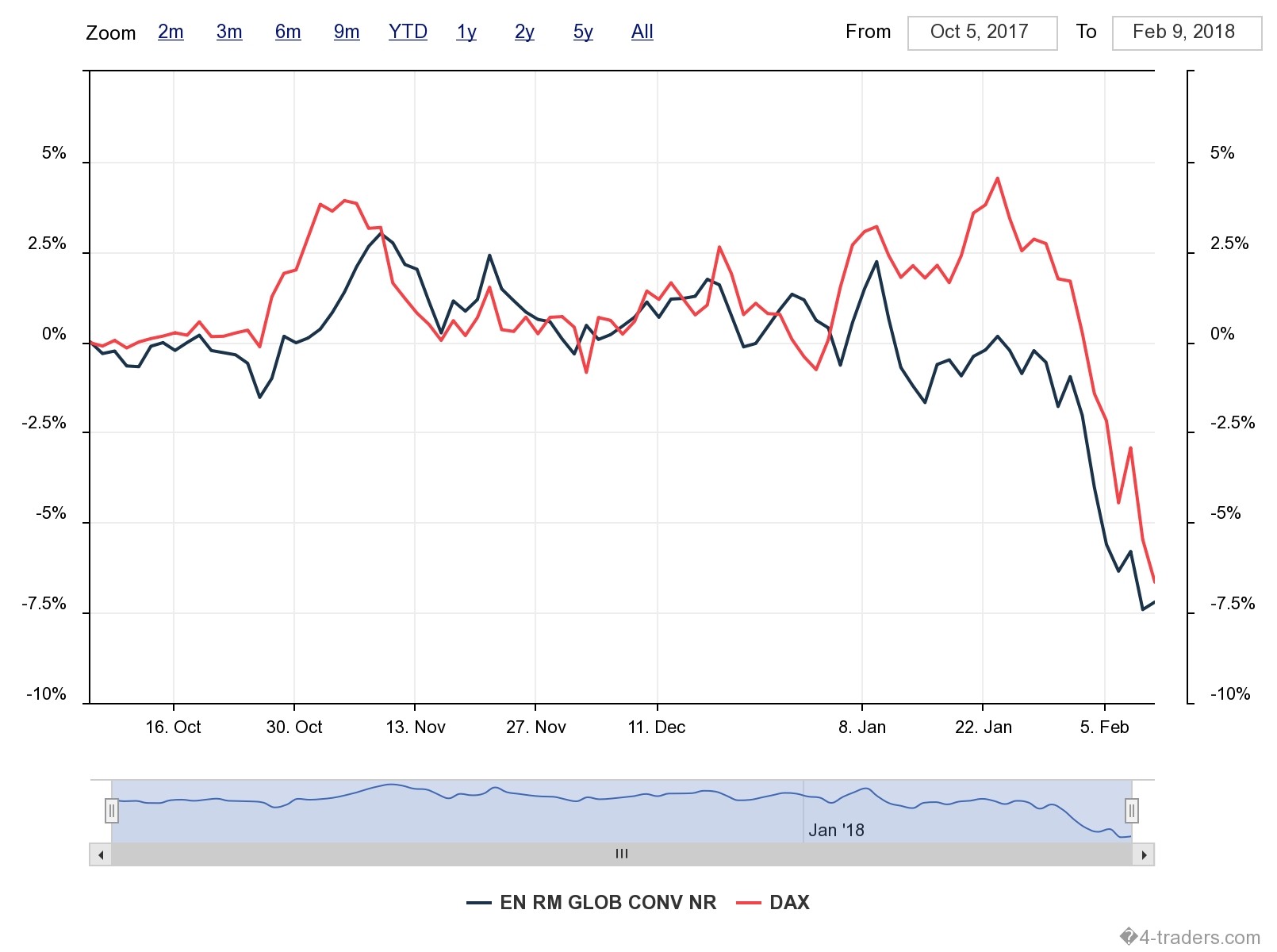
=> interessant: der REIT-Index nahm den DAX-Absturz offensichtlich vorweg.
Dieser Autor, Holger Grethe, meint am 20. Dez 2017 doch allen Ernstes:
Was spricht für die Anlageklasse Immobilienaktien?
...
2. Niedrige Korrelation mit dem Aktiengesamtmarkt
Eine niedrige Korrelation bedeutet: Die einzelnen Jahresrenditen zweier Anlageklassen weichen in einem bestimmten Zeitraum voneinander ab, entwickeln sich also nicht im Gleichlauf.
...
In den letzten 30 Jahren bewegte sich die Korrelation zwischen US-amerikanischen Aktien und REITs in einem weiten Bereich zwischen 0 und 0.85 (+).
...
aus: https://zendepot.de/immobilien-aktien-und-reits/
=> also genau dann, wenn ein Anleger einen positiven Diversifikations-Effekt mit der Anlageklasse REIT haben möchte (bzgl. seines sonstigen Aktienportfolios) bekommt er sie nicht!
=> d.h., auch die sehr hohe Korrelation von oben (+) mit 0.85, kommt mutmasslich genau in einer Krisensituation zum Tragen!
=> es bleibt dabei:
"Chasing the same signals. How black box trading influences stock markets from Wall Street to Shanghai"
von Brian R. Brown, 2010
internationale REIT's als Lösung für ein (vordergründiges) Diversifikationsproblem? (2)
Schaut man sich die jüngste Entwicklung mal an (hier der NL0012645212 -- Euronext Reitsmarket Global Conviction NR vs. DAX als Performance-Index), also mit allen Daten, die z.Z. zur Verfügung stehen, dann war's das mit der Diversifikation - weil eindeutig sehr stark korreliert:
=> interessant: der REIT-Index nahm den DAX-Absturz offensichtlich vorweg.
Dieser Autor, Holger Grethe, meint am 20. Dez 2017 doch allen Ernstes:
Was spricht für die Anlageklasse Immobilienaktien?
...
2. Niedrige Korrelation mit dem Aktiengesamtmarkt
Eine niedrige Korrelation bedeutet: Die einzelnen Jahresrenditen zweier Anlageklassen weichen in einem bestimmten Zeitraum voneinander ab, entwickeln sich also nicht im Gleichlauf.
...
In den letzten 30 Jahren bewegte sich die Korrelation zwischen US-amerikanischen Aktien und REITs in einem weiten Bereich zwischen 0 und 0.85 (+).
...
aus: https://zendepot.de/immobilien-aktien-und-reits/
=> also genau dann, wenn ein Anleger einen positiven Diversifikations-Effekt mit der Anlageklasse REIT haben möchte (bzgl. seines sonstigen Aktienportfolios) bekommt er sie nicht!
=> d.h., auch die sehr hohe Korrelation von oben (+) mit 0.85, kommt mutmasslich genau in einer Krisensituation zum Tragen!
=> es bleibt dabei:
"Chasing the same signals. How black box trading influences stock markets from Wall Street to Shanghai"
von Brian R. Brown, 2010
Antwort auf Beitrag Nr.: 56.998.380 von faultcode am 11.02.18 16:51:20
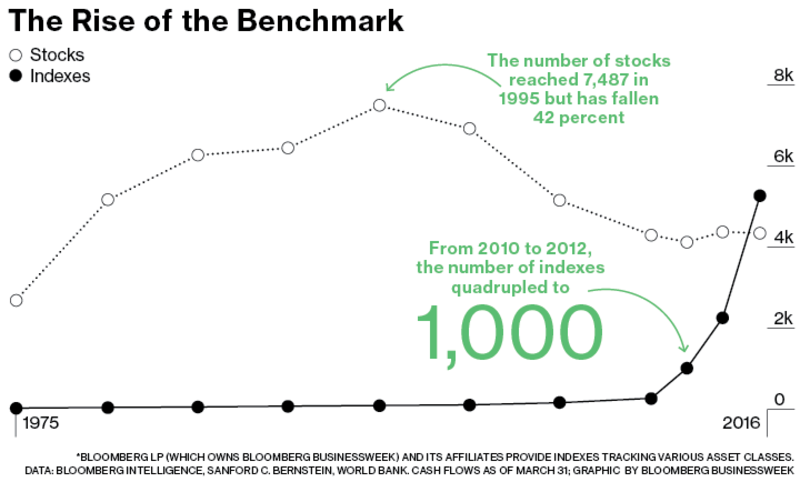
aus: https://www.bloomberg.com/news/articles/2017-05-12/there-are…
=> nichts da mit: "What drove the jump? Demand"!
=> auf diese Weise kann nämlich ein Vertreter der Sell side immer einen Index als Benchmark finden, der in der Vergangenheit sehr gut performte
=> wobei wir denn wieder beim Thema "Fooled by randomness" gemäss Nassim N. Taleb wären; cf. https://www.wallstreet-online.de/diskussion/1258587-31-40/me…
Die Index-Flut als Lösung für ein (vordergründiges) Diversifikationsproblem? (3)
Abgesehen davon: die Finanzindustrie tut sich langfristig keinen Gefallen damit, immer mehr Indizes zu kreieren:
aus: https://www.bloomberg.com/news/articles/2017-05-12/there-are…
=> nichts da mit: "What drove the jump? Demand"!
=> auf diese Weise kann nämlich ein Vertreter der Sell side immer einen Index als Benchmark finden, der in der Vergangenheit sehr gut performte

=> wobei wir denn wieder beim Thema "Fooled by randomness" gemäss Nassim N. Taleb wären; cf. https://www.wallstreet-online.de/diskussion/1258587-31-40/me…
Volatility (0)
(wenn ich mehr Zeit habe, versuche ich den VIX- und XIV-Sachverhalt von Anfang Februar irgendwie zu einfachen Erkenntnissen zusammenzufassen. Weil halt doch ein alter Klassiker an einem Finanzmarkt:- ein theoretisch Einmal-in-10.000-Jahren-Ereignis stellte sich im realen Leben dann doch eher als ein alle 10-Jahre-Ereignis heraus --> das produziert sehr schnell, binnen 48h, einige - oft zufällige - Gewinner und viele, systematische Verlierer.)
Aber zur Definition und Sprache, die oft im Zusammenhang mit Volatilität irreführenderweise verwendet wrd:
Volatility is not about "fear" nor is it about "uncertainty." Volatility occurs when options change quickly.
(gemeint ist die implizite Volatilität, die eben aus Preisen von bestimmten Optionen auf einen Aktienindex gebildet wird...)
aus: 7.2.2018:
Stock Gyrations
https://johnhcochrane.blogspot.de/2018/02/stock-gyrations.ht…
Antwort auf Beitrag Nr.: 57.036.162 von faultcode am 15.02.18 18:30:57
VDAX nach Explosion wieder halbiert. Was nun?
https://www.godmode-trader.de/analyse/volatilitaet-vdax-nach…
=> dieser Satz ist unvollständig und damit unklar:
Das Vega liegt aktuell bei 0,2. Das bedeutet, dass ein Anstieg der impliziten Vola - unter sonst gleichen Bedingungen, also isoliert betrachtet - zu einem Kursgewinn von 20 Cent im Optionsschein führen würde.
(Begriff "Vega" erscheint einmal im Artikel).
=> es muss z.B. richtig so lauten:
Das Vega liegt aktuell bei 0,2. Das bedeutet, dass ein Anstieg der impliziten Vola um einen Prozentpunkt - unter sonst gleichen Bedingungen, also isoliert betrachtet - zu einem Kursgewinn von 20 Cent im Optionsschein mit einem Bezugsverhältnis von 1:1 führen würde.
siehe z.B. aus:
https://www.boerse-stuttgart.de/de/boersenportal/boersenwiss…
=>
Neben den Kursveränderungen des Basiswertes hat meist die Veränderung der impliziten Volatilität einen großen Einfluss auf den Wert eines Optionsscheins.
...
Das Vega gibt an, um welchen Betrag ein Optionsschein sich im Wert verändert, wenn die implizite Volatilität um einen Prozentpunkt steigt. Ein Optionsschein mit einem Bezugsverhältnis von 1:1 und einem Vega von 0,5 steigt bzw. fällt um 0,50 Euro im Wert, wenn die implizite Volatilität um einen Prozentpunkt steigt oder fällt.
Volatilität in der dt. Finanzmarkt-Folklore: das Vega -- Veränderungen der Volatilität
Z.B. gerade gesehen:VDAX nach Explosion wieder halbiert. Was nun?
https://www.godmode-trader.de/analyse/volatilitaet-vdax-nach…
=> dieser Satz ist unvollständig und damit unklar:
Das Vega liegt aktuell bei 0,2. Das bedeutet, dass ein Anstieg der impliziten Vola - unter sonst gleichen Bedingungen, also isoliert betrachtet - zu einem Kursgewinn von 20 Cent im Optionsschein führen würde.
(Begriff "Vega" erscheint einmal im Artikel).
=> es muss z.B. richtig so lauten:
Das Vega liegt aktuell bei 0,2. Das bedeutet, dass ein Anstieg der impliziten Vola um einen Prozentpunkt - unter sonst gleichen Bedingungen, also isoliert betrachtet - zu einem Kursgewinn von 20 Cent im Optionsschein mit einem Bezugsverhältnis von 1:1 führen würde.
siehe z.B. aus:
https://www.boerse-stuttgart.de/de/boersenportal/boersenwiss…
=>
Neben den Kursveränderungen des Basiswertes hat meist die Veränderung der impliziten Volatilität einen großen Einfluss auf den Wert eines Optionsscheins.
...
Das Vega gibt an, um welchen Betrag ein Optionsschein sich im Wert verändert, wenn die implizite Volatilität um einen Prozentpunkt steigt. Ein Optionsschein mit einem Bezugsverhältnis von 1:1 und einem Vega von 0,5 steigt bzw. fällt um 0,50 Euro im Wert, wenn die implizite Volatilität um einen Prozentpunkt steigt oder fällt.
Pump-and-dump in Germany: the modern retiree
https://www.marketwatch.com/story/meet-the-perfect-mark-for-…=>...
That’s because new research shows that many retiree investors could hardly be more different than the stereotype of a naïve and gullible elderly widow. On the contrary, the study found, a good number of retirees turn out to be thrill seekers or gamblers who are attracted to penny-stock pump and dump schemes not out of ignorance but because of their huge risk.
The study, which the National Bureau of Economic Research recently began circulating, was conducted by Christian Leuz, a finance professor at the University of Chicago’s Booth School of Business, Leibniz University of Hanover’s Steffen Meyer, Humboldt University of Berlin’s Maximilian Muhn, Harvard’s Eugene Soltes and Goethe University of Frankfurt’s Andreas Hackethal.
It focused on individual investors who are drawn to pump-and-dump schemes. In such a scheme, of course, an unscrupulous operator will, after quietly acquiring a large position in a penny stock, circulate false stories about how the stock will soon skyrocket. The ensuing investor interest pushes the stock price much higher, allowing the perpetrator to unload his stock at a handsome profit.
The researchers studied more than 400 such schemes in Germany between 2002 and 2015.
Upon analyzing the trading records of over 110,000 individual investors from a major German bank, many of whom were retirees, the researchers found that a surprising number of these individuals—6% in fact—invested in a least one of these schemes. And they invested more than just a little amount, furthermore: Their average investment in the penny stocks was 11% of their account values, in fact. And even more surprising, given that the average investment in a scheme lost 28%, the researchers found that many individuals had invested in more than one of them.
Though the researchers didn’t focus solely on the retirees in their sample, Leuz in an interview said that they found no evidence that retirees’ propensity to invest in pump-and-dump schemes was appreciably different than it was for the non-retirees.
Most of us will be astonished by these findings, since most of us consider pump-and-dump schemes as morally, if not criminally, fraudulent. At the very least, we consider the unsolicited emails and phone calls as serious annoyances. It would never occur to us that anyone who knew better would actually want to invest in one of them.
And yet, believe it or not, they do. The researchers found evidence that many of the investors in these schemes seemed to be aware of the risks involved and proceeded anyway. The researchers speculate that these investors were being seduced by the promise of option-like payoffs of these investments, in which the odds of winning are very small but with big-enough gains when they do win to make the gamble attractive.
To be sure, Luez hastened to add, very few of the investors in their study achieved even a small profit when investing in the penny stocks at the heart of these pump-and-dump schemes—much less the huge returns that would make it even potentially attractive to incur the much-more-probable losses. Still, hope springs eternal.
An analogy to an old joke
These investors’ thought process reminds me of the old joke about an oil man who dies and approaches the Pearly Gates. St. Peter tells him that while he deserves to get into heaven, there is no more room since there are already too many oil men there. So the only way he can get in is by persuading one of the oil men already there to go to hell.
The oil man took the challenge, and pretty soon there was a steady stream of oil men headed straight to hell. St. Peter was amazed, and asked the oil man how he did it. “Easy,” he replied. “I just spread the rumor that oil had been discovered in hell.”

Just as St. Peter was opening the gates so our new oil man could go into heaven, however, he instead joined the procession of oil men to hell. Why ever why, St. Peter asked? Because, the oil man replied, you just never know; it might actually be true that oil had been discovered in hell.



If you doubt the joke’s analogy to pump-and-dump schemes, just consider an email promotion from September 2007 that the researchers refer to in their study: “We are glad to inform you of a CANCER CURE invented by [company name omitted] that will take the world by storm. This new medicine is above all other [sic] and boosts [sic] a 80% success rate during clinical trials. Over the next few days you will hear about this in the PAPERS and on TV. So buy shares now, while the price is low, before the news hits.” The misspellings and grammatical errors were in the original, so even if the content didn’t strain credulity you would have thought these other errors would have been warning enough.
Investment implications
In addition to painting a more nuanced picture of retirees and other investors, this new research points to one reason why regulators have had such difficulty putting pump-and-dump schemes out of business. The presumption has been that no one would invest in them if they knew the risks involved. At least for that subset of retirees and other investors who are thrill seekers, however, such efforts are pointless, since these investors are attracted to the schemes not out of ignorance about the risks but precisely because of them.
In an interview, Leuz said that one focus of his and his co-authors’ subsequent research will be what other possible actions regulators could take to persuade retirees and others not to be seduced by pump-and-dump schemes. But he acknowledged that it will be difficult to put those schemes out of business so long as demand for them remains widespread. After all, pumping and dumping is already questionable legally, and that has not put an end to the phenomenon.
The investment implication for each of us individually, however, is clear. If you want a thrill, buy a lottery ticket. But don’t invest your hard-earned retirement portfolio in a pump-and-dump scheme.
You’ve heard it a thousand times before, but it nevertheless remains true: If something seems too good to be true, it probably is.
=> na dann, willkommen bei WO
 Alleine schon daran gut zu erkennen, wie verwaist viele DAX30-Foren sind:
Alleine schon daran gut zu erkennen, wie verwaist viele DAX30-Foren sind: 

Hingegen "Alles unter 1€":


Antwort auf Beitrag Nr.: 55.447.173 von faultcode am 02.08.17 22:26:22
Freitags kein Crash zur Zeit (2018Q1) am US-Aktienmarkt,..
https://www.wallstreet-online.de/diskussion/1131140-260841-2… Beitrag zu dieser Diskussion schreiben
Investoren beobachten auch:
| Wertpapier | Perf. % |
|---|---|
| -0,37 | |
| -3,16 | |
| -1,28 | |
| -1,19 | |
| -1,19 | |
| +0,10 | |
| -1,24 | |
| -1,57 | |
| -1,89 | |
| +0,14 |
Meistdiskutiert
| Wertpapier | Beiträge | |
|---|---|---|
| 228 | ||
| 96 | ||
| 90 | ||
| 76 | ||
| 53 | ||
| 49 | ||
| 48 | ||
| 44 | ||
| 42 | ||
| 33 |
16:04 Uhr · dpa-AFX · Caterpillar |
15:46 Uhr · wallstreetONLINE Redaktion · Altria Group |
15:31 Uhr · wallstreetONLINE Redaktion · Dow Jones |
15:20 Uhr · BNP Paribas · Dow JonesAnzeige |
15:00 Uhr · dpa-AFX · Ford Motor |
12:21 Uhr · wallstreetONLINE Redaktion · Waste Management |
07:28 Uhr · wallstreetONLINE Redaktion · SAP |
24.04.24 · dpa-AFX · Boeing |
24.04.24 · dpa-AFX · Boeing |
24.04.24 · dpa-AFX · ASM International |
| Zeit | Titel |
|---|---|
| 23.04.24 | |
| 21.04.24 | |
| 26.03.24 | |
| 14.03.24 | |
| 22.02.24 | |
| 13.02.24 | |
| 13.02.24 | |
| 30.01.24 | |
| 26.01.24 | |
| 22.01.24 |





















